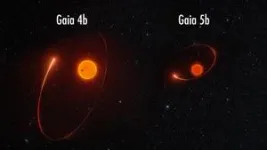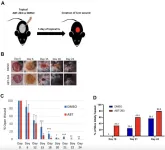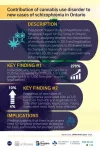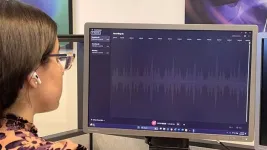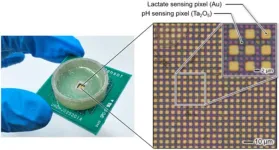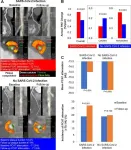(Press-News.org) NEID (rhymes with fluid) is a high-precision radial-velocity spectrograph that is designed to measure the extremely minute wobble of nearby stars using the radial velocity effect. This effect results from the mutual gravitational force between a planet and its host star which causes the star’s position to shift very slightly as the planet travels around it. With this powerful capability, one of NEID’s main science goals is to confirm exoplanet candidates found by other exoplanet missions.
NEID is funded by the NASA/NSF Exoplanet Exploration Program (NN-EXPLORE) and is mounted on the WIYN 3.5-meter Telescope at the U.S. National Science Foundation Kitt Peak National Observatory (KPNO), a Program of NSF NOIRLab.
One mission that NEID is complementing is the European Space Agency’s (ESA) Gaia spacecraft. Through its precise monitoring of the positions and motions of stars in our galaxy, Gaia is revolutionizing our understanding of many areas of astrophysics. With its exquisite precision, Gaia is expected to be able to detect thousands of exoplanets in orbit around nearby stars.
Unlike the radial velocity method used by NEID, Gaia uses a technique known as astrometry to detect a star’s motion. This technique involves measuring the subtle motion of a star as it is tugged by the gravity of an orbiting planet by looking at how the star moves compared to background or nearby stars.
Recently, as part of the latest Gaia data release, a list of stars that appear to be moving as though pulled by an exoplanet — the list of Gaia AStrometric Objects of Interest (Gaia-ASOIs) — was published. “However, the motion of these stars is not necessarily due to a planet,” said Guðmundur Stefánsson, assistant professor at the University of Amsterdam and lead author of the paper appearing in The Astrophysical Journal. “Instead, the ‘star’ might be a pair of stars that are too close together for Gaia to recognize them as separate objects. The tiny shifts in position that appear to be due to a planet might actually result from the nearly perfect cancellation of the larger shifts in position of the two stars.”
To weed out these binary stars and harvest the true planets, it is necessary to conduct follow-up observations with spectroscopy. To do so, the team used observations from NEID and two other spectrographs: the Habitable-zone Planet Finder (HPF) on the 10-meter Hobby Eberly Telescope at McDonald Observatory in Texas, and the FIES Spectrograph on the 2.6-meter Nordic Optical Telescope at La Palma in the Canary Islands.
With these powerful instruments the team conducted follow-up observations of 28 star systems with planet candidates identified by Gaia. They found that of the 28 candidate systems 21 were false positives and were actually binary star systems — two stars that orbit a common center of mass. They also confirmed that one system is a star hosting a brown dwarf [1] — an object with a mass in between those of planets and stars — but one was a star hosting a giant planet.
The newly discovered exoplanet, named Gaia-4b, has an orbital period of 570 days and a mass of 12 Jupiter masses and orbits a star 64% of the mass of the Sun. Not only is Gaia-4b the first planet ever detected by Gaia using the astrometric technique whose orbital solution is fully and independently confirmed, but it is also one of the most massive planets known to orbit a low-mass star.
“It is an exciting time for both NEID and Gaia,” says Jayadev Rajagopal, scientist at NSF NOIRLab and a co-author of the paper. “Gaia is more than living up to its promise of detecting planetary companions to stars with highly precise astrometry, and NEID is demonstrating that its long-term radial velocity precision is capable of detecting low-mass planets around those stars. With more candidate planets to come as roughly the last year of data is analyzed, this work is a harbinger of the future where Gaia discoveries of planets and brown dwarfs will need to be confirmed, or rejected, by NEID data.”
In addition to the detection of Gaia-4b and Gaia-5b, the authors provide a first glimpse of the ‘false positive rate’ of the Gaia Astrometric Exoplanet catalog, which is in the range 30–80% in their sample. This highlights the importance of ground-based observations like those possible with NEID in confirming planetary candidates in the Gaia-planet-detection era.
Notes
[1] The newly discovered brown dwarf, named Gaia-5b, is a 21-Jupiter-mass brown dwarf in a 358-day eccentric orbit around a star with 34% of the mass of the Sun.
More information
This research was presented in a paper titled “Gaia-4b and 5b: Radial Velocity Confirmation of Gaia Astrometric Orbital Solutions Reveal a Massive Planet and a Brown Dwarf Orbiting Low-mass Stars” to appear in The Astrophysical Journal. DOI: 10.3847/1538-3881/ada9e1
The team is composed of Guðmundur Stefánsson (University of Amsterdam), Suvrath Mahadevan (The Pennsylvania State University), Joshua Winn (Princeton University), Marcus Marcussen (Aarhus University), Shubham Kanodia (Carnegie Institution for Science), Simon Albrecht (Aarhus University), Evan Fitzmaurice (The Pennsylvania State University, Institute for Computational and Data Sciences Scholar), Onė Mikulskitye (University of Amsterdam), Caleb Cañas (NASA Postdoctoral Fellow, NASA Goddard Space Flight Center), Juan Ignacio Espinoza-Retamal (Pontificia Universidad Católica de Chile, Millennium Institute for Astrophysics, University of Amsterdam), Yiri Zwart (University of Amsterdam), Daniel Krolikowski (Steward Observatory, The University of Arizona), Andrew Hotnisky (The Pennsylvania State University), Paul Robertson (The University of California), Jaime A. Alvarado-Montes (Macquarie University), Chad Bender (Steward Observatory, The University of Arizona), Cullen Blake (University of Pennsylvania), Joe Callingham (Leiden University, Netherlands Institute for Radio Astronomy), William Cochran (The University of Texas at Austin), Megan Delamer (The Pennsylvania State University), Scott Diddams (University of Colorado), Jiayin Dong (Flatiron Institute, University of Illinois at Urbana-Champaign), Rachel Fernandes (The Pennsylvania State University), Mark Giovanazzi (Amherst College), Samuel Halverson (California Institute of Technology), Jessica Libby-Roberts (The Pennsylvania State University), Sarah E. Logsdon (NSF NOIRLab), Michael McElwain (NASA Goddard Space Flight Center), Joe Ninan (Tata Institute of Fundamental Research), Jayadev Rajagopal (NSF NOIRLab), Varghese Reji (Tata Institute of Fundamental Research), Arpita Roy (Schmidt Sciences), Christian Schwab (Macquarie University), and Jason Wright (The Pennsylvania State University).
The WIYN 3.5-meter Telescope is a partnership between Indiana University, University of Wisconsin–Madison, Pennsylvania State University, Princeton University, Purdue University (until 2025), NSF NOIRLab, and NASA.
NSF NOIRLab, the U.S. National Science Foundation center for ground-based optical-infrared astronomy, operates the International Gemini Observatory (a facility of NSF, NRC–Canada, ANID–Chile, MCTIC–Brazil, MINCyT–Argentina, and KASI–Republic of Korea), NSF Kitt Peak National Observatory (KPNO), NSF Cerro Tololo Inter-American Observatory (CTIO), the Community Science and Data Center (CSDC), and NSF–DOE Vera C. Rubin Observatory (in cooperation with DOE’s SLAC National Accelerator Laboratory). It is managed by the Association of Universities for Research in Astronomy (AURA) under a cooperative agreement with NSF and is headquartered in Tucson, Arizona.
The scientific community is honored to have the opportunity to conduct astronomical research on I’oligam Du’ag (Kitt Peak) in Arizona, on Maunakea in Hawai‘i, and on Cerro Tololo and Cerro Pachón in Chile. We recognize and acknowledge the very significant cultural role and reverence of I’oligam Du’ag to the Tohono O’odham Nation, and Maunakea to the Kanaka Maoli (Native Hawaiians) community.
Links
Read the paper: Gaia-4b and 5b: Radial Velocity Confirmation of Gaia Astrometric Orbital Solutions Reveal a Massive Planet and a Brown Dwarf Orbiting Low-mass Stars
ESA press release
Photos of WIYN 3.5-meter Telescope
Videos of the WIYN 3.5-meter Telescope
Check out other NOIRLab Science Releases END
High-precision NEID spectrograph helps confirm first Gaia astrometric planet discovery
The NEID spectrograph on the WIYN 3.5-meter Telescope conducted crucial follow-up observations to confirm one of the most massive planets known to orbit a low-mass star
2025-02-04
ELSE PRESS RELEASES FROM THIS DATE:
ABT-263 treatment rejuvenates aged skin and enhances wound healing
2025-02-04
“[…] topical ABT-263 effectively reduced several senescence markers in aged skin, thereby priming the skin for improved subsequent wound healing.”
BUFFALO, NY—February 4, 2025 — A new research paper was published by Aging (Aging-US) on December 3, 2024, in Volume 17, Issue 1, titled “Topical ABT-263 treatment reduces aged skin senescence and improves subsequent wound healing.”
Researchers Maria Shvedova, Rex Jeya Rajkumar Samdavid Thanapaul, Joy Ha, Jannat ...
The challenge of pursuit – how saccades enable mammals to simultaneously chase prey and navigate through complex environments
2025-02-04
How do predators use their vision to both navigate through the terrain whilst tracking prey running for its life? Pursuing prey through a complex environment is a major challenge for the visual system as not only do the prey constantly change direction, sometimes in the opposite direction to the pursuer, but running after something evokes self-induced motion-blur which degrades vision. In a study, published in Current Biology, researchers reconstructed the visual fields of freely moving ferrets as they chased a fleeing target. They discovered that the eye saccades, like those that normally track objects when sitting still, aligned the motion of the environment, ...
Music can touch the heart, even inside the womb
2025-02-04
WASHINGTON, Feb. 4, 2025 – Playing music has long been a way for expectant parents to connect with their children in the womb, but a group of researchers has found evidence it can calm fetal heart rates, potentially providing developmental benefits.
In Chaos, by AIP Publishing, researchers from the Autonomous University of the State of Mexico, the Metropolitan Autonomous University, the General Hospital Nicolás San Juan, and the National Institute of Cardiology Ignacio Chávez studied the effect of classical music on a fetal heartbeat. The team used mathematical analysis tools to identify patterns in heart rate variability.
Typical measures ...
Contribution of cannabis use disorder to new cases of schizophrenia has almost tripled over the past 17 years
2025-02-04
Ottawa, ON, February 4, 2025 – The proportion of new cases of schizophrenia associated with a cannabis use disorder has risen from 4% pre-legalization to 10% after cannabis legalization in Ontario, according to new research.
A new study from researchers at ICES, The Ottawa Hospital, University of Ottawa’s Department of Family Medicine, and Bruyère Health Research Institute and published in the journal JAMA Network Open used data capturing the healthcare visits of everyone living in Ontario, Canada to track whether the liberalization of medical cannabis in 2015 and legalization of non-medical ...
Listening for multiple mental health disorders
2025-02-04
WASHINGTON, Feb. 4, 2025 – It’s no secret that there is a mental health crisis in the United States. As of 2021, 8.3% adults had major depressive disorder (MDD) and 19.1% had anxiety disorders (AD), and the COVID-19 pandemic exacerbated these statistics. Despite the high prevalence of AD/MDD, diagnosis and treatment rates remain low – 36.9% for AD and 61.0% for MDD – due to a variety of social, perceptual, and structural barriers. Automated screening tools can help.
In JASA Express Letters, published on behalf of the Acoustical Society ...
Visualization of chemical phenomena in the microscopic world using semiconductor image sensor
2025-02-04
<Overview>
A research team led by Professor Kazuaki Sawada and Project Assistant Professor Hideo Doi of the Department of Electrical and Electronic Information Engineering, Toyohashi University of Technology has developed a semiconductor sensor enabling the real-time observation of two types of biomolecule dynamics in solutions. By using semiconductor technology to pattern a thin metal film functioning as a neurotransmitter-sensitive membrane on sensor pixels arranged two-dimensionally in a 2 µm pitch, the sensor captures the movement of hydrogen ions and lactate ...
Virus that causes COVID-19 increases risk of cardiac events
2025-02-04
OAK BROOK, Ill. – A new study found severe acute respiratory syndrome coronavirus 2 (SARS-CoV-2) infection was associated with the rapid growth of plaque in the coronary arteries and an increased risk of cardiovascular events. The results were published today in Radiology, a journal of the Radiological Society of North America (RSNA).
“COVID-19, caused by SARS-CoV-2, is initially characterized by acute lung injury and respiratory failure,” said the study’s senior author, Junbo Ge, M.D., professor and director of the Cardiology Department at Zhongshan Hospital, Fudan University in Shanghai, ...
Half a degree rise in global warming will triple area of Earth too hot for humans
2025-02-04
New assessment warns area the size of the USA will become too hot during extreme heat events for even healthy young humans to maintain a safe body temperature if we hit 2°C above preindustrial levels.
For those aged over 60, the same 2°C rise would see more than a third of the planet’s land mass cross this critical ‘overheating’ threshold
An international group of scientists, led by King’s College London, has revealed how continued global warming will lead to more parts of the planet becoming too ...
Identifying ED patients likely to have health-related social needs
2025-02-04
INDIANAPOLIS -- Addressing patients’ health-related social needs such as housing instability, food insecurity, transportation barriers and financial strain is important to improving health outcomes yet can be challenging. A new study from Regenstrief Institute and Indiana University Indianapolis Richard M. Fairbanks School of Public Health investigates the best approach to predicting likely need for one or more health-related social need services.
To identify emergency department (E.D.) patients needing these services, researchers ...
Yo-yo dieting may significantly increase kidney disease risk in people with type 1 diabetes
2025-02-04
WASHINGTON—Body-weight cycling (also known as yo-yo dieting) has been shown to significantly increase the risk of kidney disease in people with type 1 diabetes, regardless of body mass index (BMI) and other traditional risk factors, according to a new study published in the Endocrine Society’s Journal of Clinical Endocrinology & Metabolism.
Yo-yo dieting is defined as repeatedly losing and gaining weight multiple times over the years. Its prevalence is reported to be as high as 35% in men and 55% in women.
This patten of dieting has been shown to increase risks of cardiovascular events ...
LAST 30 PRESS RELEASES:
Heart-brain connection: international study reveals the role of the vagus nerve in keeping the heart young
Researchers identify Rb1 as a predictive biomarker for a new therapeutic strategy in some breast cancers
Survey reveals ethical gaps slowing AI adoption in pediatric surgery
Stimulant ADHD medications work differently than thought
AI overestimates how smart people are, according to HSE economists
HSE researchers create genome-wide map of quadruplexes
Scientists boost cell "powerhouses" to burn more calories
Automatic label checking: The missing step in making reliable medical AI
Low daily alcohol intake linked to 50% heightened mouth cancer risk in India
American Meteorological Society announces Rick Spinrad as 2026 President-Elect
Biomass-based carbon capture spotlighted in newly released global climate webinar recording
Illuminating invisible nano pollutants: advanced bioimaging tracks the full journey of emerging nanoscale contaminants in living systems
How does age affect recovery from spinal cord injury?
Novel AI tool offers prognosis for patients with head and neck cancer
Fathers’ microplastic exposure tied to their children’s metabolic problems
Research validates laboratory model for studying high-grade serous ovarian cancer
SIR 2026 delivers transformative breakthroughs in minimally invasive medicine to improve patient care
Stem Cell Reports most downloaded papers of 2025 highlight the breadth and impact of stem cell research
Oxford-led study estimates NHS spends around 3% of its primary and secondary care budget on the health impacts of heat and cold in England
A researcher’s long quest leads to a smart composite breakthrough
Urban wild bees act as “microbial sensors” of city health.
New study finds where you live affects recovery after a hip fracture
Forecasting the impact of fully automated vehicle adoption on US road traffic injuries
Alcohol-related hospitalizations from 2016 to 2022
Semaglutide and hospitalizations in patients with obesity and established cardiovascular disease
Researchers ‘listen in’ to embryo-mother interactions during implantation using a culture system replicating the womb lining
How changing your diet could help save the world
How to make AI truly scalable and reliable for real-time traffic assignment?
Beyond fragmented markets: A new framework for efficient and stable ride-pooling
Can shape priors make road perception more reliable for autonomous driving?
[Press-News.org] High-precision NEID spectrograph helps confirm first Gaia astrometric planet discoveryThe NEID spectrograph on the WIYN 3.5-meter Telescope conducted crucial follow-up observations to confirm one of the most massive planets known to orbit a low-mass star

